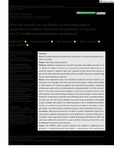What the curtains do not shield: A phenomenological exploration of patient‐witnessed resuscitation in hospital. Part 2: Healthcare professionals' experiences
| dc.contributor.author | Fiori, M | |
| dc.contributor.author | Coombs, M | |
| dc.contributor.author | Endacott, Ruth | |
| dc.contributor.author | Cutello, CA | |
| dc.contributor.author | Latour, Jos M | |
| dc.date.accessioned | 2022-04-29T12:06:13Z | |
| dc.date.issued | 2022-03-24 | |
| dc.identifier.issn | 0309-2402 | |
| dc.identifier.issn | 1365-2648 | |
| dc.identifier.uri | http://hdl.handle.net/10026.1/19126 | |
| dc.description.abstract |
<jats:title>Abstract</jats:title><jats:sec><jats:title>Aims</jats:title><jats:p>To explore healthcare professionals' experiences of patient‐witnessed resuscitation in hospital.</jats:p></jats:sec><jats:sec><jats:title>Design</jats:title><jats:p>Descriptive phenomenology.</jats:p></jats:sec><jats:sec><jats:title>Methods</jats:title><jats:p>Healthcare professionals involved in hospital resuscitation activities were recruited from medical, intensive care, resuscitation and education departments in a university hospital in England. Data were collected through face‐to‐face and focus group interviews, between August 2018 and January 2019. Data were analysed using Giorgi's phenomenological approach.</jats:p></jats:sec><jats:sec><jats:title>Results</jats:title><jats:p>Nine registered nurses, four healthcare assistants and seven doctors participated in four individual interviews and three focus groups. Findings were related to three themes: (1) Protecting patients from witnessing resuscitation: healthcare professionals used curtains to shield patients during resuscitation, but this was ineffective. Thus, they experienced challenges in explaining resuscitation events to the other patients and communicating sensitively. (2) Emotional impact of resuscitation: healthcare professionals recognized that witnessing resuscitation impacted patients, but they also felt emotionally affected from performing resuscitation and needed coping strategies and support. (3) Supporting patients who witnessed resuscitation: healthcare professionals recognized the importance of patients' well‐being, but they felt unable to provide effective and timely support while providing life‐saving care.</jats:p></jats:sec><jats:sec><jats:title>Conclusion</jats:title><jats:p>Healthcare professionals involved in hospital resuscitation require specific support, guidance and education to care effectively for patients witnessing resuscitation. Improving communication, implementing regular debriefing for staff, and allocating a dedicated professional to support patients witnessing resuscitation must be addressed to improve clinical practice.</jats:p></jats:sec><jats:sec><jats:title>Impact</jats:title><jats:p>The WATCH study uncovers patients' and healthcare professionals' experiences of patient‐witnessed resuscitation, a phenomenon still overlooked in nursing research and practice. The main findings highlight that, in common with patients, healthcare professionals are subject to the emotional impact of resuscitation events and encounter challenges in supporting patients who witness resuscitation. Embedding the recommendations from this research into clinical guidelines will impact the clinical practice of healthcare professionals involved in hospital resuscitation and the quality and timeliness of care delivered to patients.</jats:p></jats:sec> | |
| dc.format.extent | 2596-2607 | |
| dc.format.medium | Print-Electronic | |
| dc.language | en | |
| dc.language.iso | eng | |
| dc.publisher | Wiley | |
| dc.subject | cardiac arrest | |
| dc.subject | cardiopulmonary resuscitation | |
| dc.subject | emergency treatment | |
| dc.subject | health personnel | |
| dc.subject | hospitals | |
| dc.subject | interviews | |
| dc.subject | nurses | |
| dc.subject | patients | |
| dc.subject | qualitative research | |
| dc.subject | resuscitation | |
| dc.title | What the curtains do not shield: A phenomenological exploration of patient‐witnessed resuscitation in hospital. Part 2: Healthcare professionals' experiences | |
| dc.type | journal-article | |
| dc.type | Journal Article | |
| plymouth.author-url | https://www.webofscience.com/api/gateway?GWVersion=2&SrcApp=PARTNER_APP&SrcAuth=LinksAMR&KeyUT=WOS:000772675100001&DestLinkType=FullRecord&DestApp=ALL_WOS&UsrCustomerID=11bb513d99f797142bcfeffcc58ea008 | |
| plymouth.issue | 8 | |
| plymouth.volume | 78 | |
| plymouth.publication-status | Published | |
| plymouth.journal | Journal of Advanced Nursing | |
| dc.identifier.doi | 10.1111/jan.15219 | |
| plymouth.organisational-group | /Plymouth | |
| plymouth.organisational-group | /Plymouth/Faculty of Health | |
| plymouth.organisational-group | /Plymouth/Faculty of Health/School of Nursing and Midwifery | |
| plymouth.organisational-group | /Plymouth/REF 2021 Researchers by UoA | |
| plymouth.organisational-group | /Plymouth/REF 2021 Researchers by UoA/UoA03 Allied Health Professions, Dentistry, Nursing and Pharmacy | |
| plymouth.organisational-group | /Plymouth/Research Groups | |
| plymouth.organisational-group | /Plymouth/Research Groups/Institute of Health and Community | |
| plymouth.organisational-group | /Plymouth/Research Groups/Plymouth Institute of Health and Care Research (PIHR) | |
| plymouth.organisational-group | /Plymouth/Users by role | |
| plymouth.organisational-group | /Plymouth/Users by role/Academics | |
| dc.publisher.place | England | |
| dcterms.dateAccepted | 2022-02-10 | |
| dc.rights.embargodate | 2022-4-30 | |
| dc.identifier.eissn | 1365-2648 | |
| dc.rights.embargoperiod | Not known | |
| rioxxterms.versionofrecord | 10.1111/jan.15219 | |
| rioxxterms.licenseref.uri | http://www.rioxx.net/licenses/all-rights-reserved | |
| rioxxterms.licenseref.startdate | 2022-03-24 | |
| rioxxterms.type | Journal Article/Review |


